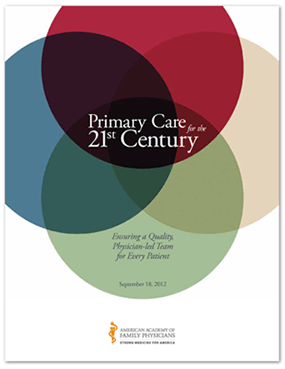
The AAFP this week launched its report “Primary Care for the 21st Century: Ensuring a Quality, Physician-led Team for Every Patient ”
The United States is adopting a new model of primary care built around patients and delivered by teams. As a key element of this approach, primary care medical practices are being called upon to do more, and to do it better, while managing resources ever more wisely. This approach is generally known as the patient-centered medical home (PCMH).1 It has proven to increase quality of care for the patient and cost-effectiveness for the health care system.2
Within a medical home, each patient has an ongoing relationship with a personal physician trained to provide first contact, complex diagnosis, and continuous, comprehensive care. The personal physician leads a team of professionals at the practice level who are collectively responsible for the ongoing care of patients— many of whom are living with one or more chronic conditions. This reorganization puts primary care at the center of the patient’s team and better enables doctors, nurse practitioners (NPs), physician assistants, nurses, and other health care professionals to work side by side in caring for patients.
Yet even as the role and complexity of primary care practice expands, there has been a significant amount of discussion within the health care and public policy communities about advanced practice nurses directing primary care practices on their own, without a physician on staff. This effort to have nurses practice independent of physicians comes at the very same moment that medical practice itself is changing to an integrated, team-based approach that includes physicians and other health professionals. These two approaches take the country and our health care system in opposite and conflicting directions.
The rationale behind most proposals to allow nurse practitioners to practice independently is that the nation is facing a primary care physician shortage. This is true. But substituting NPs for doctors cannot be the answer. Nurse practitioners are not doctors, and responsible leaders of nursing acknowledge this fact. Dr. Kathleen Potempa, the dean of the University of Michigan School of Nursing and president of the American Association of Colleges of Nursing told the New York Times that, “Nurses are very proud of the fact that they’re nurses, and if nurses had wanted to be doctors, they would have gone to medical school.”3 Dr. Potempa is right—nurse practitioners do not have the substance of doctor training or the length of clinical experience required to be doctors.4 For example, for licensure, NPs receive only 5.5-7 years of education compared with 11 years for a physician.5 The clinical experience that NPs receive within that education is only one-fifth of the clinical experience a physician receives.6
The nation can fill the primary care gap through the continuing transition to team-based care in medical homes, with all health professionals playing valuable and appropriate roles. Studies show the ideal practice ratio of NPs to physicians is approximately 4-to-1.7 With PCMHs built around that ratio, everyone can have a primary care doctor and receive the benefits of team-based care. The American Academy of Family Physicians believes it is axiomatic that every American should have a primary care physician and benefit from care provided in a PCMH where team-based care leads to improved quality and cost efficiency.
The full report is available at

